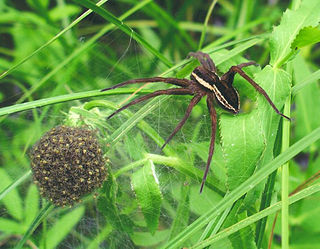
Dolomedes is a genus of large spiders of the family Dolomedidae. They are also known as fishing spiders, raft spiders, dock spiders or wharf spiders. Almost all Dolomedes species are semiaquatic, with the exception of the tree-dwelling D. albineus of the southeastern United States. Many species have a striking pale stripe down each side of the body.

The raft spider, scientific name Dolomedes fimbriatus, is a large semi-aquatic spider of the family Dolomedidae found throughout north-western and central Europe. It is one of only two species of the genus Dolomedes found in Europe, the other being the slightly larger Dolomedesplantarius which is endangered in the UK.
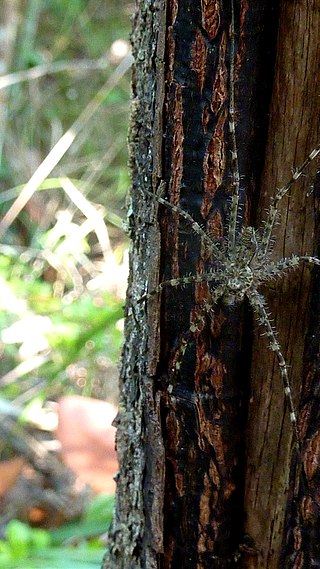
Trechaleidae (tre-kah-LEE-ih-dee) is a family of araneomorph spiders first described by Eugène Simon in 1890. It includes about 140 described species in 16 genera. They all live in Central and South America except for Shinobius orientalis, which is endemic to Japan. Other names for the family are longlegged water spiders and fishing spiders. The family Trechaleidae is closely related to Pisauridae and Lycosidae, and the three families are sometimes referred to as the lycosid group.

Dolomedes minor is a spider in the family Dolomedidae that is endemic to New Zealand, where it is known as the nursery web spider.

The great raft spider or fen raft spider is a European species of spider in the family Dolomedidae. Like other Dolomedes spiders, it is semiaquatic, hunting its prey on the surface of water. It occurs mainly in neutral to alkaline, unpolluted water of fens and grazing marsh.

Dolomedes tenebrosus, known as the dark fishing spider, is a species of fishing spider found in the United States and Canada.
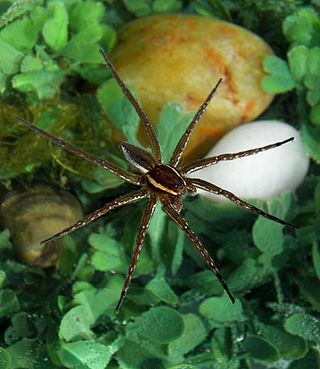
The six-spotted fishing spider is a species of spider in the family Dolomedidae. Found in wetland habitats throughout North America, these spiders are usually seen scampering along the surface of ponds and other bodies of water. They are also referred to as dock spiders because they can sometimes be witnessed quickly vanishing through the cracks of boat docks. D. triton gets its scientific name from the Greek mythological god Triton, who is the messenger of the big sea and the son of Poseidon.
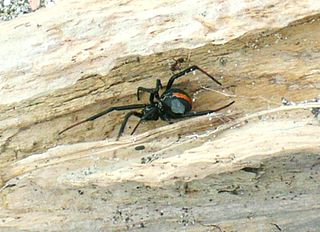
New Zealand has 1157 described spider species, with an estimated total fauna of 2000 species. Over 97 per cent are endemic, and the rest have been introduced through human activities or were natural wind-borne introductions.
Dolomedes elegans is a species of spider in the family Dolomedidae, found in French Guiana.
Dolomedes boiei, is a species of spider of the genus Dolomedes. It is native to Java and Sri Lanka.
Dolomedes karschi is a species of spider of the genus Dolomedes. It is endemic to Sri Lanka.

Dolomedes schauinslandi or the Rangatira spider is a large spider of the family Dolomedidae. It is only found on South East Island (Rangatira), Houruakopara and Mangere Islands in the Chatham Islands, New Zealand. It is one of New Zealand's largest and rarest spiders.
Dolomedes gertschi is a species of nursery web spider in the family Dolomedidae. It is found in the United States.

Dolomedes vittatus is a species of spider in the family Dolomedidae. It is found in the United States.

Dolomedes albineus, the white-banded fishing spider, is a species of spider in the family Dolomedidae. It is found in the United States. Like most Dolomedes, this spider tends to hunt at or in streams and ponds. It has special hairs that repel water, allowing it to walk on water, and trap an air bubble on its abdomen to dive and swim, so that it can hunt tadpoles and aquatic invertebrates.

Dolomedes okefinokensis is a species of spider in the family Dolomedidae. It is found in the United States.

Dolomedes striatus is a species of spider in the family Dolomedidae. It is found in the United States and Canada.
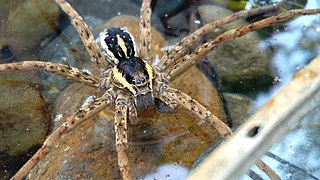
Dolomedes dondalei is a species of large fishing spider endemic to the main islands of New Zealand. It is a nocturnal hunter, feeling the water surface for vibrations, and catches insects and even small fishes – the only New Zealand Dolomedes species able to do so.
Dolomedes venmani is a species of spider in the family Dolomedidae.

Megadolomedes trux is a species of spider endemic to Australia in the family Dolomedidae.















